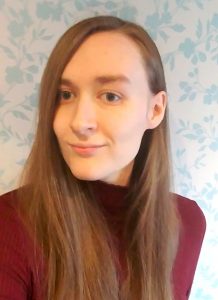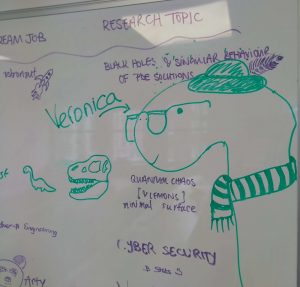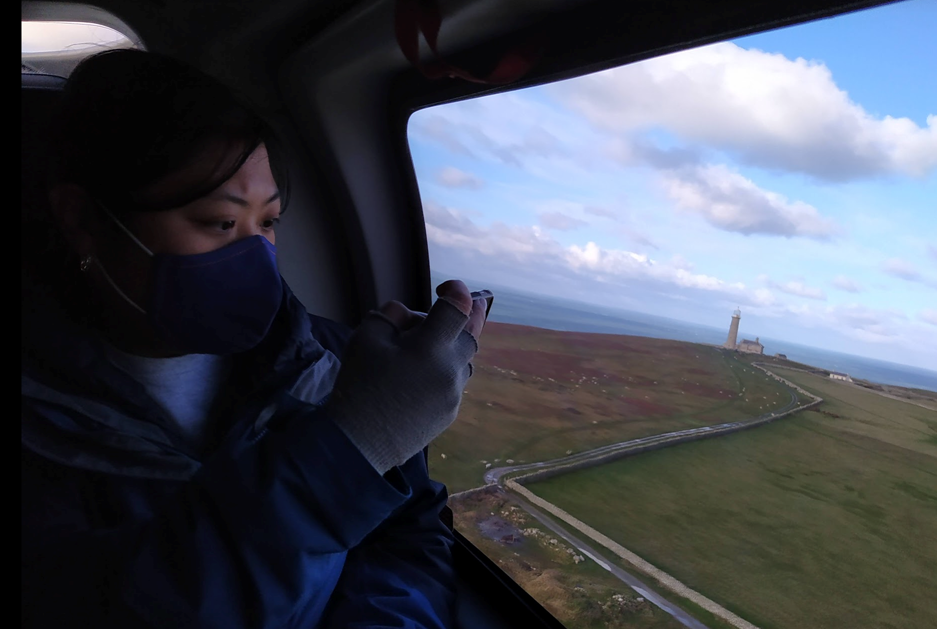Self-belief and a life-changing Fellowship: the summer I spent as a pseudo PhD student

The Mary Lister McCammon Summer Research (MLMC) Fellowship gives female university students a funded opportunity to spend the summer before their final year at university working on a ten-week research project with a leading mathematician or statistician. Participants get the chance to spend time with current PhD students to find out what studying a PhD is actually like, plus briefings on how to apply for a PhD and the kinds of programmes and funding streams which are available.
Katherine Holmes was a participant on the programme in summer 2019, and is now studying a PhD in Quantum Dynamics in the Department of Mathematics. In this blog post she reflects on how the Fellowship influenced her – both academically, and also on much more personal level.
A little about me
Hello, my name is Katherine and I am a first year PhD student studying Quantum Dynamics with my supervisor Dr Eva-Maria Graefe.
Before Imperial, I studied on the MMath (Maths with Masters) course at the University of Nottingham (UoN). My undergraduate degree there was very positive – it was, after all, where I discovered my passion for Quantum Mechanics. I feel very thankful that UoN provided many opportunities to study the different branches of Quantum, and also thankful to be able to continue learning about the field as part of a PhD at Imperial. I’ve been doing the PhD for about four months now, and am genuinely loving it.
Am I good enough?
I feel humbled to say, however, that if it were not for the Mary Lister McCammon Summer Research Fellowship, I would not have had the self-belief to pursue a PhD. The MLMC Fellowship is a funded programme and I was part of the first cohort of during the summer of 2019. It brought together fourteen brilliant women studying mathematics from across the country to be treated as “pseudo-PhD students” for ten weeks. When I first heard about the opportunity, I got excited and nervous. “This sounds incredible!” I thought, “but am I really capable of this sort of research?” I had a fair few doubts about myself when I applied in the third year of my undergraduate degree. Specifically, I knew I had found my passion in theoretical physics and that I am good student, but was I good enough? This question of “am I good enough?” sprung in mind many times during my academic journey, largely because I have dyslexia, and that tore down my confidence that I could produce research and write a thesis.
The best summer I ever had

In the end, I decided to be bold and apply. I got accepted and, crying tears of joy, went to tell my parents! Thus, I began the best summer I ever had. The goal of the MLMC Fellowship is to simulate life as a PhD student, including giving a wage equivalent to a PhD stipend, which was enough to cover accommodation in Imperial halls, cost of living and a little extra spending money to have fun with. My cohort also had access to a computer room. It was given to us as an “office” but we spent just as much time treating it as a social space. Working along side the cohort was a pleasure. We all had backgrounds in wildly different areas in mathematics, which can be difficult to communicate. We were, however, all united in the friendly conversations we had about how we should have a Diplodocus as our mascot: her name was Veronica.
Talking bread, bikes and “Quantum Billiards”
Each one of us had a topic to focus our research on, and we were also all paired with a supervisor with expertise in that area. Mine was Quantum Dynamics with Dr Eva-Maria Graefe and Dr Jessica Eastman. When we first met, we talked about bread and bikes before anything mathematical. Such a relaxed conversation made me feel very welcome. Then after a couple cups of tea, they suggested the research topic of “Quantum Billiards”. They knew I had MATLAB experience, so what if I made a code that simulated classical billiards, i.e. what you find in any good pub, specifically a model of a ball bouncing around a table. Then we make it quantum, where we make the ball tiny and we don’t know exactly where it is on the table, such that it’s in a superposition. That sounded exciting to me and I agreed to the topic.
So this was the beginning of the journey. I got into a good routine of coming into the office four days a week and working one day in the comfort of halls. The work was enjoyable and made me a MATLAB convert, so much so that I’m now looking forward to coding on the software during my actual PhD project.
A day in the life of an MLMC Fellow and the importance of a cohort teapot
Doing proper research is very interesting. Some days you’ll make lots of progress, some days you’ll get nowhere and other days you just want to scheme with fellow group members to buy a cohort teapot and make each other tea. One nice difference from being treated like an undergraduate compared to a postgraduate is, when doing a degree you are told regularly to constantly work hard, but during a PhD and similar projects there’s an emphasis on “don’t work too hard, look after yourself”, which is a healthy mentality to share. There is no doubt you are capable and hard-working, so you should also have fun and spend time maintaining your mental wellbeing – and sometimes a healthy approach to wellbeing means going to Argos at 2pm on a Tuesday to buy a tea pot.
We did have a little structure in our week. We had talks from speakers every couple of weeks about research opportunities and experiences, as well as “tea and chat” with current PhD students. They were very helpful and informative. The true highlight, though, was communication training with Justine Jones. These three-hour sessions boiled down to “applied improv”, taking the skills you develop in improvised acting and putting them to use in an academic setting. They were some of funniest moments of the Fellowship, and in the end we all become more skilled and confident giving professional presentations.
Realising my own potential
As the weeks went on, my confidence improved as much as my billiards codes improved. Some days I got stuck, but I had the regular contact and support of my supervisors to move past any hurdles. Solutions were discovered and codes finished. After two weeks we had classical billiards, and after five weeks we had quantum billiards. As if winning the game itself, I had a revelation: I was good enough to do a PhD. Not only did I complete the work, I really enjoyed it, and the insecurities that had held me back disappeared as I realised my own potential. The MLMC Fellowship changed my life because it was the opportunity I needed to show myself that I am good enough follow my passion and pursue quantum mechanics further.
We all feel we’re not good enough at some point in our lives, even though often we are already good enough. But knowing we are, and actually believing that, can be two very different things. Advancing in academia is a challenge that a lot of us won’t feel capable of. This fellowship is for women because there is a huge drop in the number of women taking part in Mathematics PhDs compared to undergraduate study. It’s hard to say why, but maybe it comes down to many of us thinking “I’m not good enough”.
My advice is, if you are a woman eligible for this Fellowship, especially if you find yourself unsure about your research skills, then apply. The Fellowship, of course, might be different in future than my experiences, due to the pandemic. But nevertheless, it will provide you the similar opportunity to see if a PhD is for you. In the end you have nothing to lose by trying. Maybe you will be a future Fellow. Maybe you’ll have a transformative time, and then maybe you’ll be walking the campus as a PhD student in years to come.
Apply for the Fellowship
Applications for June 2021 are now open! Applications will close on 1 March 2021. Find out more about the programme and how to apply.
Due to the pandemic, last year’s programme ran entirely remotely, including all project supervision, communications training, seminars, and social activities. Our 2020 fellows reported that the summer was still both valuable and enjoyable. The format of the 2021 fellowship will depend on the COVID-19 situation this summer. If an in-person programme is possible, then we will offer this. If it is still necessary for the programme to be remote then this is what we will do.

 We started our journey in the early morning of November 30. We were taken to the helipad of the Hartland point of Bideford. The journey from Imperial to Bradford took approximately five hours; from there it took only ten minutes from the Heartland to Lundy Island by helicopter! I was a bit nervous, but at the same time was amazed to see the beauty of the Bristol channel and the granite outcrop from the sky.
We started our journey in the early morning of November 30. We were taken to the helipad of the Hartland point of Bideford. The journey from Imperial to Bradford took approximately five hours; from there it took only ten minutes from the Heartland to Lundy Island by helicopter! I was a bit nervous, but at the same time was amazed to see the beauty of the Bristol channel and the granite outcrop from the sky.